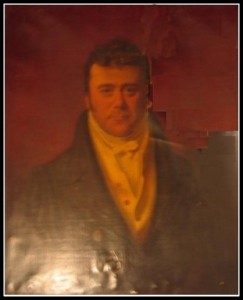Who was the Mr Harding of Harding’s Pits?
The man who gave his name to the area which is now the Doorstep Green has been the subject of speculation and a favourite talking point for friends of the Green ever since its opening in 2004.

A good claimant to the title has now emerged in the form of William Derisley Harding, engineer and farmer and, by the sound of things, very much the archetypal Victorian public servant.

In the latter years of the 19th century he served as engineer to the Bedford Level Corporation, responsible for the upkeep of the various rivers of the Fens and the drainage of thousands of acres of the finest farm land in Britain; in addition to his responsibilities for ensuring that the many pumps, sluices and locks and the miles of embankments were maintained in good order, this Mr Harding was also the superintendent of the River Great Ouse Outfall Board and a Commissioner of Sewers. (Commissioners of Sewers were responsible for land drainage in specific areas such as the Fens from the 17th century until the introduction of internal drainage boards in the 1930s).
In the mid-19th century Mr Harding was in business at King’s Lynn as a manufacturer and repairer of steam engines, a lucrative enterprise in the days when the Fens were still being drained and steam was taking over from the horse as the primary motive power on the farms.
He would doubtless have been in head to head competition with Lynn’s biggest industrialist of the time, Frederick Savage, who arrived in the town from Dereham in 1851. Savage’s made a whole range of agricultural and fairground machinery and perhaps the competition was too strong for Mr Harding and his partner, Joseph Turner, because they closed their business in 1858, Mr Harding announcing in the London Gazette of 5th February of that year that he would be responsible for all debts owed by the business and would receive all moneys owed to it.

He continued to thrive, though because, probably prior to 1860, he built the grand mansion Islington Lodge on land which he had bought from the Eau Brink Commissioners in 1850 and where he farmed with pigs, potatoes and wheat. This was highly productive land that had been reclaimed from the bed of the River Ouse thirty years before and it is quite possible that the Doorstep Green site came as part of the purchase.
The house, enthusiastically described in a sales brochure many years later as having ‘a plethora of wonderful Victorian features’ and ‘fabulous parkland-style grounds’ was built with bricks handmade on the site in kilns the remains of which remained to be seen many years later. Here he lived with his wife, Louisa, and brought up seven children before his death in 1897. Members of the family continued living there up to the 1920s.
Islington Lodge still stands in its own grounds a mile or two outside Lynn to the east of the old Wisbech Road.
For much of the above information we are indebted to Martin and Cynthia Harding. Mr Harding was born in the UK, but now lives in Bermuda. He is the great-great grandson of William Derisley Harding.
